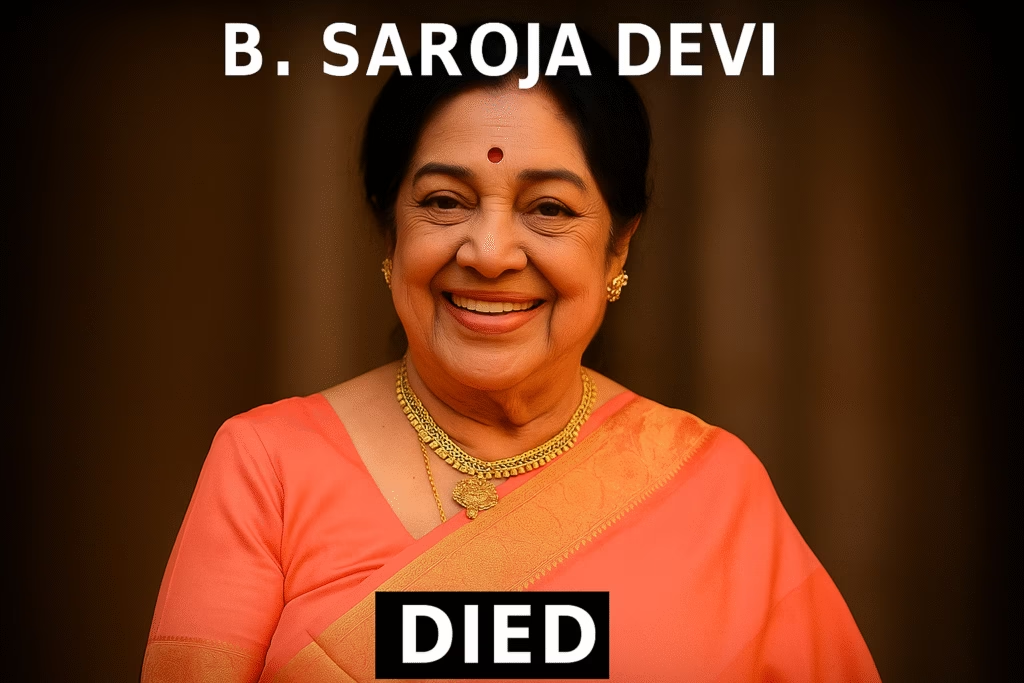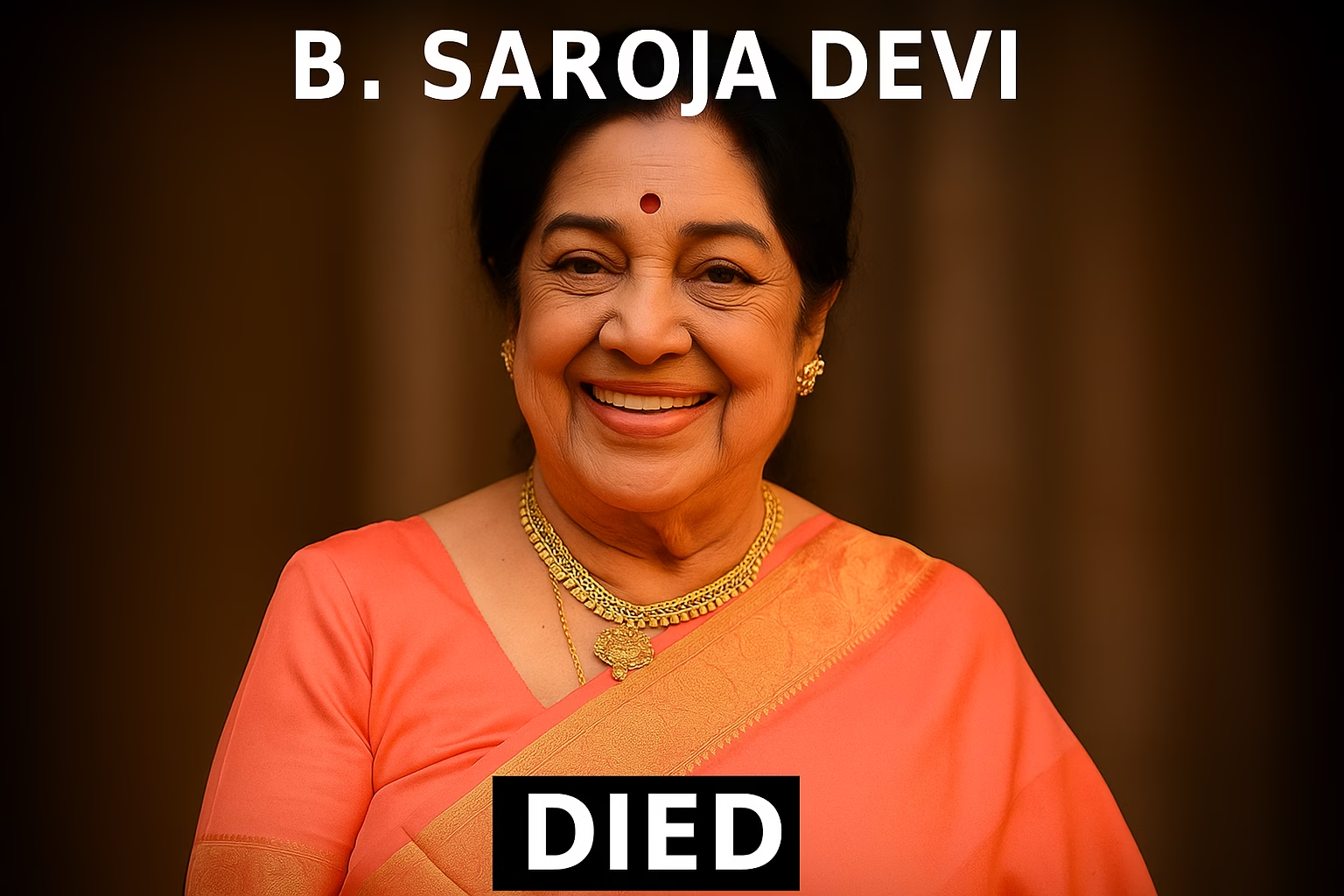By Ankit kumar | July 2025 In the grand tapestry of Indian cinema, a luminous thread has come undone. B. Saroja Devi —fondly remembered as “Abhinaya Saraswathi” (the Goddess of Expression) and “Kannadathu Paingili” (the Queen of Kannada Femininity)—left us at the age of 87. A beacon of grace, talent, and resilience, her passing not only marks the end of a life well-lived, but also the dimming of a radiant star that inspired generations across four languages and countless hearts.

🌱 Himalayan Humility: A Star is Born
Born to a humble family and natural performer, Saroja Devi(Abhinaya Saraswathi) made her cinematic debut at just 17 with the 1955 Kannada film Mahakavi Kalidasa. Even at that tender age, her presence felt older, wiser—and entirely authentic. It was here that audiences first witnessed her expressive eyes, her intuitive acting, and that gift for emotion that would earn her the title “Abhinaya Saraswathi”.
Four years later, fate would hold a grander stage. In 1958’s Nadodi Mannan, she co-starred opposite Tamil superstar M. G. Ramachandran (MGR). The film blazed through theatres, lighting the path toward national recognition. Overnight, she became a beloved leading lady across the South—Kannada, Tamil, Telugu—and even in Bollywood.
🌏 A Cinematic Odyssey in Four Tongues
(Abhinaya Saraswathi)Saroja Devi’s filmography reads like a testament to pan-Indian appeal: over 200 movies in Kannada, Tamil, Telugu, and Hindi. She became one of the rare actresses whose career thrived across regional divides.
In Kannada, she ruled as the beloved counterpart to Dr. Rajkumar, enriching narratives with emotion and elegance. In Telugu, she brought sensitivity and strength, especially in her debut Panduranga Mahatyam (1957). In Tamil, she graced stages alongside legends Sivaji Ganesan and MGR in classics like Nadodi Mannan. In Hindi, she brought the same expressiveness to Bollywood’s storytelling.
Among her many co-stars: MGR and Sivaji Ganesan, N. T. Rama Rao and Rajkumar, and Hindi icons like Shammi Kapoor. In Nadodi Mannan, she wasn’t just MGR’s heroine—she was the soul of that legendary spectacle.
🌟 Beyond the Screen: Strength, Service, Stardom
Abhinaya Saraswathi’s artistry extended far beyond acting. In 1969, she earned the Padma Shri; in 1992, the Padma Bhushan—two of India’s most distinguished civilian honors. She also received Tamil Nadu’s Kalaimamani Award, and an honorary doctorate from Bangalore University, acknowledging both excellence and influence.
Her civic service ran deep. As vice-president of the Kannada Chalanchitra Sangha, and chairperson of the 53rd National Film Awards jury, she shaped not only films but the film community itself. Her sharp eye for storytelling and her commitment to cultural integrity ensured future generations benefited from her discerning perspective.
🕰️ The Woman Behind the Applause
In interviews, Saroja Devi (Abhinaya Saraswathi) spoke not of fame, but of discipline, character, and humility. She credited her parents for cultivating her love of performance, and credited the industry for keeping her grounded. Off-camera, she was known for kindness—treating junior artists with respect, extending a mentor’s hand to newcomers, and quietly supporting causes in education and women’s welfare.
Abhinaya Saraswathi eschewed controversy, choosing instead a life of quiet dignity. Fans recall her calm presence at shoots, sharing wisdom rather than gossip. Colleagues remember her witty, self-effacing humor. These stories make her passing feel less like saying goodbye to a screen icon, and more like losing a cherished family elder.
🎭 A Career of Firsts, Records, and Resonance
- 1955 – Mahakavi Kalidasa marked her age‑17 debut in Kannada cinema.
- 1957 – Enters Telugu films with Panduranga Mahatyam.
- 1958 – Soars to fame opposite MGR in Nadodi Mannan.
- 1955–1984 – A staggering 161 consecutive films as heroine across 29 years—a national record.
- Shared marquee space with icons like MGR, Sivaji Ganesan, NTR, and Rajkumar.
- Honored with Padma Shri (1969), Padma Bhushan (1992), Kalaimamani, and a doctorate—celebrating both art and character.
- Leader in film circles: vice-president of the Kannada film body and National Awards jury chair.
Each point in her career reads like a deep well of devotion—to the craft of cinema, to authenticity, and to enduring artistry.
RELATED: Farewell to Kota Srinivasa Rao: Legend is No More.
🌄 End of an Era: Loss Felt Nationwide
When the news of her passing surfaced on OneIndia and other media this week, the outpouring was immediate and heartfelt. Fans across India lit lamps in her memory. Theatres dimmed their lights in tribute. Tributes flowed from current stars, filmmakers, cultural institutions—many recalling her as synonymous with dignity and the essence of natural artistry.
From Bangalore to Chennai, Hyderabad to Mumbai, filmmakers remember the vanished era she represented—an era where cinema was poetry, and the actress was both muse and mentor.
💬 Voices of Grief & Gratitude
- A contemporary actress said, “Madam taught us that acting is breathing truth—not memorizing lines.”
- A director recalled never creating a scene “that she couldn’t fill with layer upon layer of emotion.”
- A fan in Mysore remarked, “When she smiled, her eyes spoke entire dialogues.”
These and countless more testimonies echo the sorrow—yes—but mostly the gratitude of those touched by her screen warmth.
🌸 A Legacy Beyond Films
Her legacy isn’t just the 200+ credits or the national honors; it lives in every performance that followed her style—lyrical, expressive, understated. It lives in acting schools where students study her measured pauses, expressive glances, and that gift for making even silence speak.
When she chaired the National Film Awards jury, she didn’t just judge films; she shaped cinematic priorities—encouraging integrity over star power, substance over spectacle.
Even as decades have passed since her most dazzling roles, her influence remains. Every new talent citing her as inspiration is a testament to a legacy that remains perpetually present.
🌿 Mourning and Celebration
Over the next month, memorial programs across South India will pay homage—special screenings of her iconic films, panel discussions on her craft, tender rose‑studded tributes at cultural halls in Bangalore, Chennai, and Hyderabad.
Relatives request donations in her name toward arts education, especially for young girls—continuing her lifelong belief in nurturing future talent.
All this marks not only mourning, but celebration: of a life devoted to cinematic excellence, moral integrity, and cultural contribution.
SOURCE: TIMES OF INDIA
🧭 Lessons For Future Generations
- Art rooted in authenticity: Saroja Devi (Abhinaya Saraswathi) personified roles by internalizing them—never mimicry, always sincerity.
- The power of consistency: Nearly 30 straight years as leading actress show enduring professionalism.
- Cultural responsibility: She balanced screen success with steady civic involvement and guidance.
- Grace under pressure: Whether facing fame or criticism, she remained composed, respectful, and dignified.
These lessons define an artist’s responsibility—not just to entertain, but to inspire.
🌅 Final Farewell: A Prayer, A Promise
And so, as the sun sets on the life of B. Saroja Devi (Abhinaya Saraswathi), we remember her not in shadow, but in radiance. A woman who played queens, goddesses, lovers, mothers—and in doing so, became an enduring symbol of cinematic artistry.
Let this be a promise from us: to cherish her films anew, to introduce her performances to younger audiences, to keep alive the values she embodied.
Her journey from Mahakavi Kalidasa to decades of stardom, her pan‑Indian reach, her artistic integrity, and her societal contributions—form the portrait of a true icon. Her name will continue to be uttered with affection, her flickering images revisited with awe, and her legacy carried forward by every quietly brilliant performance that follows her trail.
Rest in Peace, B. Saroja Devi garu—Abhinaya Saraswathi, Kannadathu Paingili, and the embodiment of elegance in Indian cinema. Your screen is dimmed, but your light will forever illuminate the hearts of all who witnessed your craft.

